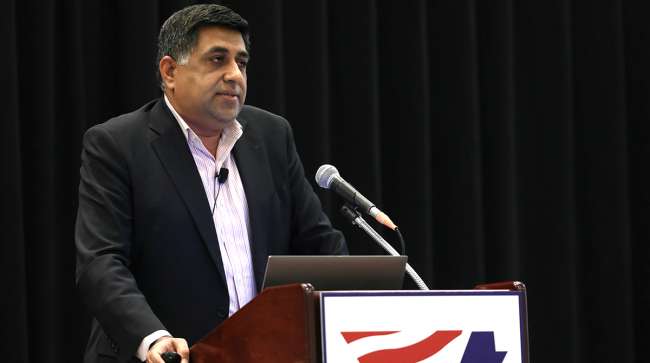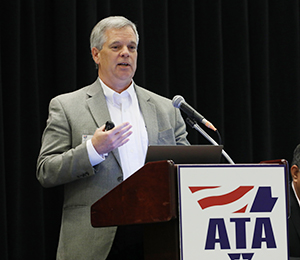Managing Editor, Features and Multimedia
Charging Infrastructure Key Factor for Electric Truck Deployments

[Stay on top of transportation news: Get TTNews in your inbox.]
NASHVILLE, Tenn. — As trucking fleets test and deploy their first electric-powered commercial trucks, they will need to navigate a learning curve that extends far beyond the vehicle itself.
Several industry experts discussed the many considerations that factor into the design and installation of electric truck-charging infrastructure during an Oct. 24 educational session here at American Trucking Associations’ 2021 Management Conference & Exhibition.
“It is not only a vehicle technology problem,” said Rakesh Aneja, head of eMobility at Daimler Trucks North America. “On top of that we have to take care of the infrastructure, and also equally, if not more importantly, in the end these trucks have to make money for our end customers.”
Aneja said the rollout of battery-electric trucks and the infrastructure to support them will require many partnerships.
“Our industry is faced with its biggest transformation ever,” he said. “Today, more than ever before, there is a critical need for all stakeholders — policymakers, regulatory bodies, truck OEMs, suppliers, utility and energy providers — to come together for a common cause.”

Rowand says a fleet of 50 electric Class 8 trucks has a peak electricity demand on par with the Empire State Building. (John Sommers II for Transport Topics)
Supporting a fleet of electric trucks involves much more than simply installing charging hardware at a depot, said Mike Rowand, director of engineering and technical services for eTransEnergy, a fleet electrification business owned by power company Duke Energy.
“When you’re looking at that charging station, you’re really just seeing the tip of the iceberg,” he said. “That’s the visible part. That’s the part that you’re going to interact with. But there’s a lot below the surface that is involved in infrastructure.”
Other components of the charging ecosystem include the facility’s electrical infrastructure, the utility service infrastructure and other energy resources such as backup generators or solar power, he said.
Plus, as fleets explore deploying electric trucks, they will need to understand their current and future electricity demand, select charging equipment that fits their operations and ensure that their vehicles and charging systems are compatible.
DTNA’s Aneja recommended that fleets utilize smart software to optimize the interaction between the vehicle and the charging system and reduce costs.
A complete, cohesive charging ecosystem can also include local, on-site energy generation through solar power, for example.
Over time, as EV batteries reach the end of their useful life in trucking applications, those aging batteries could be repurposed for energy storage at infrastructure sites, he added.

Research shows that 41% of technicians leave the industry within the first two years. Host Michael Freeze asks, how can technician recruiters and maintenance leaders decrease that percentage? We talked with Ana Salcido of Navistar and Stacy Earnhardt of TMC. Hear a snippet above, and get the full program by going to RoadSigns.TTNews.com.
An electric vehicle’s specifications can influence the fleet’s charging infrastructure needs, which in turn may affect electricity costs.
“Those things interact with each other with your electric vehicle in a way that they don’t with liquid fuel vehicles,” eTransEnergy’s Rowand said.
When and how a fleet charges its electric trucks can have a huge effect on total electricity costs, so companies will need to understand electric tariffs.
As an example, Rowand said that charging a truck overnight for 10 hours could cost 8 cents per kilowatt hour, but fast charging that same truck in 30 minutes might cost 72 cents per kilowatt hour, nine times more.
Rowand said a fleet of 50 electric Class 8 trucks has a peak electricity demand on par with the Empire State Building.
Infrastructure resiliency is another key consideration, he said.
“What happens when there’s a power outage? It’s not as simple as bringing in a tanker truck with diesel.”
Options include on-site or portable backup generators, as well as solar power, he said.
As electric trucks continue to reach the market, the trucking industry is working to develop a better understanding of how to best deploy these vehicles in real-world freight applications.

Legler
“The question is, how are we going to get from concept to operation? This is kind of where we are in the industry right now,” said Jack Legler, technical director for ATA’s Technology & Maintenance Council. “We are seeing the early adopters out there running test fleets very successfully and starting to figure out the equation.”
TMC currently has 12 task forces dedicated to developing position papers or recommended practices related to implementing electric trucks, said Kevin Otto, chairman of TMC’s Electrified Vehicle Task Force.
Future topics for exploration include charging connector standardization, charging system maintenance, considerations for public charging stations and safety protocols for maintenance shops, Otto said.
Want more news? Listen to today's daily briefing below or go here for more info:


